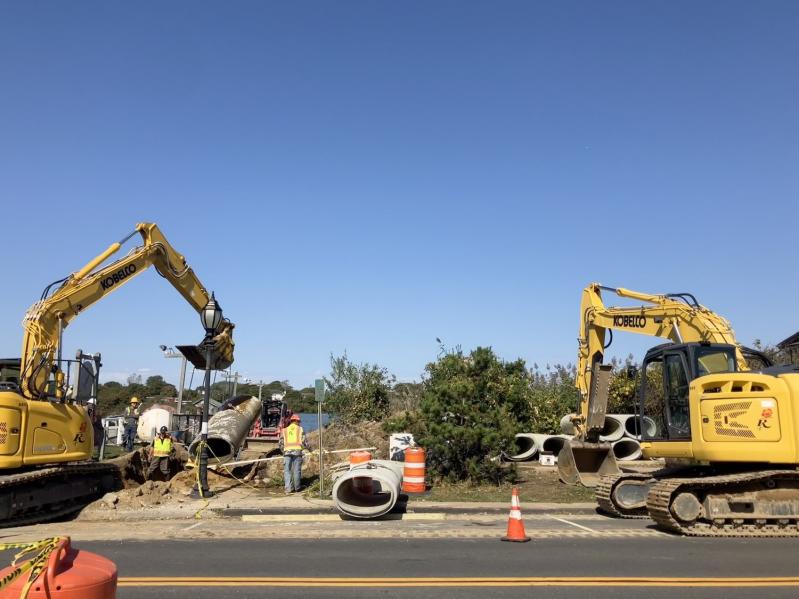Work began late last month in Montauk on a New York State Department of Transportation drainage project on Route 27 at Fort Pond that could ease flooding but add contaminants to the struggling water body. In fact, Concerned Citizens of Montauk says that if the project continues, and the group expects it will, the D.O.T. will be breaking state and federal law by sending unfiltered stormwater directly into the pond.
Current drainage, which includes two overtaxed and clogged drains at Kirk Park and a corrugated metal pipe buried beneath Puff and Putt Mini Golf and Boat Rentals, can’t move the water off the roadway fast enough. It floods. The floodwater eventually works its way through the buried pipe, under unsuspecting mini-golfers, and directly into Fort Pond. Drivers drifting by Kirk Park, likely thinking more of the ocean than Fort Pond, probably don’t realize they’re only 18 inches above the pond as they pass this low point on Route 27.
The project involves plugging the old pipe with concrete and installing a new one, once again allowing stormwater to flow directly into the pond. The two drains at Kirk Park will be replaced.
The project has been moving forward for years, and C.C.O.M. detailed its concerns during a public comment period in 2021.
“The National Pollutant Discharge and Elimination System, administered and regulated by the New York State Department of Environmental Conservation strictly prohibits the direct discharge of stormwater into surface waters under the Illicit Discharge Detection and Elimination parameter,” wrote Laura Tooman, then president of the environmental nonprofit. “I urge the D.O.T. to look at alternative green infrastructure options that would treat and infiltrate the storm water given the significant water quality impairments Fort Pond suffers from.”
Kimberly Shaw, the East Hampton Town natural resources director, also submitted a letter to the D.O.T. “The Town of East Hampton is opposed to the New York State D.O.T. storm drain improvement project. Replacing the aging storm drainpipe and developing an alternative upland plan combined with advanced treatment is the preferred alternative,” she wrote to James Fonda, the chief engineer for the project.
Months later, in April 2022, both C.C.O.M. and Ms. Shaw received correspondence back from Mr. Fonda (in fact, the same exact letter), assuring them that the D.O.T. had “identified an opportunity to collect stormwater from the south gutterline located to the west of the low point and direct it to an existing upland outfall inside of Kirk Park to limit direct discharge to Fort Pond.”
However, a month later when the D.O.T. presented its final plan, there was no mention of water treatment.
“We don’t know what happened in that month,” said Rebecca Holloway, manager of environmental advocacy for C.C.O.M. Once the final plan was presented, there was no further communication from the D.O.T. regarding the project. The September start date surprised everyone.
“In this situation,” said East Hampton Town Councilman David Lys, “The state could have communicated better. At the same time, we’re happy they came out to repair this drainage, and parts of East Hampton Village, Wainscott, and Amagansett in the last year. They’re actively working on all the drainage, so I thank them for that.”
In a statement by email yesterday, a D.O.T. spokesman said that the department is “committed to preserving natural resources on Long Island while enhancing highway safety. Relative to the ongoing drainage project along State Route 27, a new stone filtration system is being constructed and a new discharge pipe is being installed, which will enhance the resiliency of the existing infrastructure. Additionally, runoff from a nearby Town of East Hampton parking lot is now being redirected toward wetlands along State Route 27 at no cost to the town, addressing previous concerns raised by the community while significantly lessening the amount of water entering Fort Pond.”
“The project is moving to completion, but nonetheless, C.C.O.M. is taking this very seriously,” said Ms. Holloway. “We hope to use it to highlight the negative effects of road runoff and to show it’s time to pursue other options for flood mitigation.” In a slight nod to criticisms leveled by the town and C.C.O.M., the new pipe will be fitted with geotextiles to filter runoff, which will run over a bed of riprap before it reaches the pond.
“There is an ability to capture large materials and suspended solids, like organic matter, with that method of filtration,” said Ms. Holloway. “However, the extent of effectiveness is often very limited. Specifically with regard to pollutants and nutrients that are a huge concern for Fort Pond. Nitrogen, phosphorus, and motor oils will be left largely untreated. We are also concerned about the maintenance of geotextile and stone. We don’t know how long that limited filter will be effective.”
In partnership with the Surfrider Foundation’s Blue Water Task Force, C.C.O.M. tests two areas of Fort Pond weekly. Recent results have been poor. The last, from Sept. 30, show “high bacteria” levels, with enterococcus at 443 parts per 100 milliliters of water. In the last year, results have ranged from less than 10 parts to 1,169 parts per 100 milliliters. Any reading over 100 is considered high. The Suffolk County Department of Health reported blue-green algae blooms on the pond last summer.
“It’s not like this was a one-shot chance at improving the water quality there,” said Ms. Holloway. “With our consistent testing, we will be able to show if this method has been effective. We hope this helps highlight the issue and keeps water quality health top of mind in the town.”




